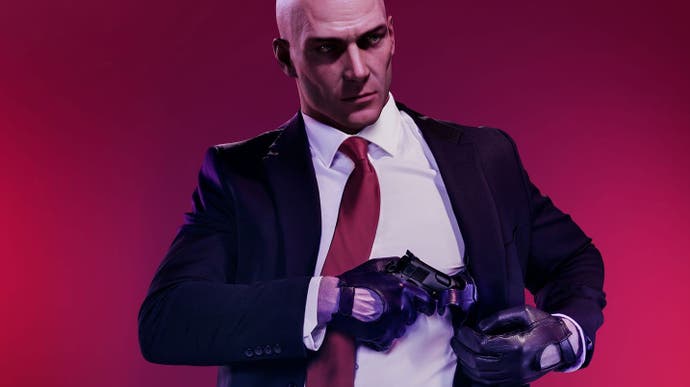Hitman 2 review - a surgical to the point of slender sequel
IOU.
In a characteristically indirect show of political engagement, I spent much of this week's US mid-term elections wandering around Whittleton Creek, Hitman 2's idyllic slice of American suburbia. If nothing else, there's a (more coherent) parody of Donald Trump canvassing the neighbourhood in the shape of a local congressional wannabe. Speak to him, and you'll be treated to a cynical diatribe on immigrants and cleaning up politics. Strangle and dress as him, and you can spout a bit of populist invective yourself in a bid to get one of your quarries alone. A horseshoe of grand clapboard mansions presiding over snooker table lawns, the map is both a study in privilege and an opportunity for Io Interactive to play more overtly with the layers of social permissiveness that make up its brilliant stealth game. It's also, for my money, the best part of a sequel that is essentially a season's worth of DLC maps with a bow on top, padded out with tweaked legacy content from Hitman 2016 plus a fun competitive mode.
Fittingly in a game that trades too much on past accomplishments, Whittleton Creek's masterstroke is that most houses follow the same rough blueprint. Each has, however, been put to different use by the people living there, and the enjoyment lies in exploring these differences as you become familiar with recurring layouts and sightlines. One story mission target is a diseased one-percenter whose rooms are packed with bodyguards and cultish memorabilia (disguise yourself as one of the former and the old fool might insist on talking you through the collection, away from prying eyes). A few fences over there's a welcome-to-the-neighbourhood party in full swing, a public space where you can intercept the mission's other target, serve fries with optional rodenticide and overhear a few useful conversations. In one second floor mancave walled with baseball jerseys and movie posters a sketchpad lies open in which some vapid soul has been practicing his autograph. Across the hall in another, deserted property, rusty smudges on the plaster attest to a recent murder.
Agent 47 himself is as lethal and preposterous a protagonist as ever, his greatest weapon not the razor-wire coiled in his pocket or the silenced pistol tucked discreetly behind his hip, but his ability to impersonate anybody from a cartoon mascot to a corpse. The sequel's seven maps (including a tutorial area) once again see you robbing innocent bystanders of their clothes to trick watchful eyes and close the distance to your quarry. Once near, you'll want to look for opportunities to get your victim alone or things you can sabotage - breathing masks, stage pyrotechnics, car-raising mechanisms - to bring about their demise.
Each mission completion expands your portfolio of killing instruments, from sniper rifles you can have smuggled to a safehouse before arrival to remotely detonated mines you might leave in a suitcase for unsuspecting guards to recover. Often, though, the more satisfying tools for the job are the things you find lying around. At Hitman's core is an ethic of wreaking vengeance on the powerful, be it a vain movie producer or a Columbian druglord's head of PR. The game's dress-up system essentially puts the lie to the idea that the rich are a different and worthier breed by showing that what we wear defines us - and how better to punish them for their presumption than by turning their own belongings against them? Mulching a businessman's brains with his own putting iron is riskier, but sends a louder message than just snuffing him out with your sniper rifle.

Many of these poetic ironies form part of the moderately scripted assassination gambits you'll find woven into the texture of each map, most triggered by overhearing a conversation. As with the 2016 game's Opportunity system, it's best to disable the associated HUD cues and waypoints if you want to appreciate the deviousness of these tactics - by default, you'll be jumping through hoops. You might also want to turn off HUD aids like the radial awareness system which indicates that somebody suspects you of foul play (people who know the person whose clothes you've pinched won't be fooled by your disguise for long). In general, the more you strip from Hitman's interface the more delight you'll squeeze from its NPC sandbox, but don't worry if you'd rather leave the waterwings on during your first playthrough: the game's Contract system, whereby players can generate their own hits with specific targets and tactics, should provide ample reason to revisit maps.
New to this iteration is localised voice-acting, where the last game had NPCs from every country speak American English. This makes more obvious the fact that Agent 47 is basically a long-running joke about Anglo-Saxon features being a kind of universal currency, accepted everywhere even when screamingly out of place. The dialogue pokes fun at this throughout - in Mumbai, one Indian magnate reacts to the discovery that his portrait painter now looks like Captain Picard on steroids by remarking on the quality of your shave. In Miami, meanwhile, there's the chance to inspect a line-up of prototype android assassins while dressed as a visiting general. "I prefer the human touch," quips Agent 47, during a demonstration of facial recognition technology you are free to abuse.

Sadly, while the maps are pretty strong (save for a rather phoned-in opening seaside level) there's nothing here that's quite as exciting or weird as the pick of Hitman 2016. Mumbai is the busiest, spanning a half-constructed modern skyscaper, a gorgeous deserted railyard with velveteen, colonial era carriages, and a tangle of alleyways thronged with rickshaws and open-air stalls (the ability to actually pass through crowds, rather than bumping around them like furniture, adds much to the game's recreation of one of the world's most densely populated cities). It's lent intrigue by the fact that one of your story mission targets is incognito to begin with, though if you leave too many HUD aids on you'll find that flushing him out is insultingly straightforward. The Miami chapter, meanwhile, gives you the tour of a racing event with a tech expo bolted onto it. In a brilliant touch, the race unfolds as you explore, offering a parallel sequence of events for you to take advantage of. One of your targets is a driver, and it's possible to kill her at any stage in the proceedings from the pitstop to the podium.
Columbia offers more visual variety, with rundown villages giving way to thick jungle and then to the glistening grounds of a druglord's mansion, but I found it too dependent on Agent 47's newfound ability to take cover in tall vegetation. Though useful and not, of course, obligatory, this trick feels like a concession to more generic stealth games rather than an engrossing new tool for Hitman.
The map that should be the game's crowning glory also falls a bit flat. It sees you infiltrating an island masquerade held by an Illuminati-style organisation, and includes a nod to Hitman: Blood Money's legendary Requiem scene together with a couple of assassination gambits that revolve around stealing trinkets left in public view. It doesn't, however, do as much to differentiate itself from previous chapters as a finale really should (the game's sub-Bond overarching narrative also ends on a frustrating cliffhanger, in a reflection of the project's previous status as an episodic game). In general, I think Io could take returning players a little further out of their comfort zones, with maps that render some approaches more difficult or which cause you to think afresh about hand-worn tools. But then, that's what contracts are for, to say nothing of the new Ghost mode, a head-to-head option in which players race one another to murder randomly spawned VIP targets.
Players are visible to one another in Ghost Mode but can't interact directly, or affect what happens in each other's worlds save by killing the target first. This lack of a direct connection is a bit disappointing - I'd have loved something in the vein of Assassin's Creed's old multiplayer, with participants indistinguishable from NPCs till caught in acts of non-computerly behaviour, and the fact that you always know who your NPC target is kills a lot of the suspense. But it's still possible to sabotage an opponent by forcing them to rush, galloping through high security areas in the wrong attire in order to steal back a point and stave off defeat. It's also deeply satisfying when you nail a quarry a hair's breadth ahead of your foe, catching them with a remote mine as the other player switches triumphantly to their garrotting wire. It's a promising start to Hitman's multiplayer career, and the lack of any accompanying CoD-style equipment grinding system means that it's always everybody's game to win.

Hitman 2 is not the landmark the last game was, and given that it almost didn't happen at all, with Io wresting back the rights from Square Enix at the eleventh hour, that's only to be expected. It doesn't take us anywhere drastically unfamiliar for Hitman - all the maps have precedents in older games, and for all the multitude of smaller tweaks, like NPCs spotting you in mirrors or picture-in-picture footage of people you've successfully distracted, the rhythms are exactly those of the 2016 outing. There's plenty to go back to in each map, however, from Trumpian politicians to that slowly unlocking repertoire of subtler or more grandiose strategies, and in Ghost, at least, the suggestion of a series turning a new leaf. I hope Io has the chance to follow through, because Hitman remains one of the smartest stealth experiences out there and truly a game for unequal times - a window upon society in which spoiled elites always get what's coming to them, by fair means or foul.











